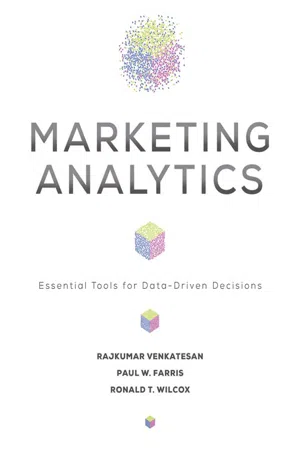
Marketing Analytics
Essential Tools for Data-Driven Decisions
- 336 pages
- English
- ePUB (mobile friendly)
- Available on iOS & Android
Marketing Analytics
Essential Tools for Data-Driven Decisions
About this book
The authors of the pioneering Cutting-Edge Marketing Analytics return to the vital conversation of leveraging big data with Marketing Analytics: Essential Tools for Data-Driven Decisions, which updates and expands on the earlier book as we enter the 2020s. As they illustrate, big data analytics is the engine that drives marketing, providing a forward-looking, predictive perspective for marketing decision-making.
The book presents actual cases and data, giving readers invaluable real-world instruction. The cases show how to identify relevant data, choose the best analytics technique, and investigate the link between marketing plans and customer behavior. These actual scenarios shed light on the most pressing marketing questions, such as setting the optimal price for one's product or designing effective digital marketing campaigns.
Big data is currently the most powerful resource to the marketing professional, and this book illustrates how to fully harness that power to effectively maximize marketing efforts.
Frequently asked questions
- Essential is ideal for learners and professionals who enjoy exploring a wide range of subjects. Access the Essential Library with 800,000+ trusted titles and best-sellers across business, personal growth, and the humanities. Includes unlimited reading time and Standard Read Aloud voice.
- Complete: Perfect for advanced learners and researchers needing full, unrestricted access. Unlock 1.4M+ books across hundreds of subjects, including academic and specialized titles. The Complete Plan also includes advanced features like Premium Read Aloud and Research Assistant.
Please note we cannot support devices running on iOS 13 and Android 7 or earlier. Learn more about using the app.
Information
1
Resource Allocation
RESOURCE ALLOCATION: FOUR STEPS
- Determine the objective metric that captures the business outcome of interest.
- Develop a function that connects marketing inputs to the objective metric.
- Using historical data on marketing inputs and the objective metric, employ marketing analytics to estimate the unknown values or parameters of the function identified in step 2.
- Now reverse the process: keep the parameters identified in step 3 fixed, and find the optimal marketing input levels that would maximize the objective metric to determine the best resource allocation.
Step 1: Determine the Objective Metric
Step 2: Develop a Function that Connects Marketing Inputs to the Objective Metric
Step 3: Estimate the Parameters of the Function Identified in Step 2
Table of contents
- Cover
- Title Page
- Copyright
- Contents
- Foreword
- Introduction
- 1. Resource Allocation
- 2. Cluster Analysis
- 3. Conjoint Analysis
- 4. Linear Regression
- 5. Customer Lifetime Value
- 6. Marketing Experiments
- 7. Paid Search Advertising
- 8. Text Analytics
- 9. Logistic Regression
- 10. Recommendation Systems
- 11. Automation of Marketing Models
- 12. Implementing Marketing Analytics
- Acknowledgments
- Notes
- Further Resources
- Index